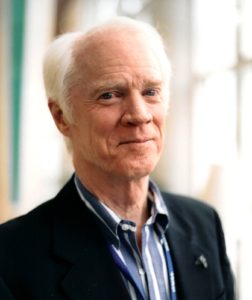15 Years of Asteroid Hunting — B612 Reaches its 15th Birthday by Rusty Schweickart
October 11, 2017
This post is written by B612 Co-founder, Rusty Schweickart. Rusty is an American aeronautical engineer, and a former NASA astronaut, U.S. Air Force fighter pilot, as well as a retired business executive and co-founder of B612 Foundation.
October 7 marked 15 years since B612 was formed to protect the Earth from asteroid impacts. Each day this week, five founding board members will each reflect on B612’s 15 years.
 Wow, 15 years! But no, it doesn’t seem like just yesterday. It frankly seems like a long time ago that Ed Lu and Piet Hut got the group of us together in October 2001 at the Johnson Space Center to ask those 2 critical questions: If we know that it’s just a matter of time before we find an asteroid with our address on it, is there anything we can do about it? Finding that the answer to #1 is yes, is there something the group of us could do to bring that about? Yes, form the B612 Foundation!
Wow, 15 years! But no, it doesn’t seem like just yesterday. It frankly seems like a long time ago that Ed Lu and Piet Hut got the group of us together in October 2001 at the Johnson Space Center to ask those 2 critical questions: If we know that it’s just a matter of time before we find an asteroid with our address on it, is there anything we can do about it? Finding that the answer to #1 is yes, is there something the group of us could do to bring that about? Yes, form the B612 Foundation!
In these subsequent 15 years, we’ve gotten a lot done and stimulated huge changes in the field. In fact, we essentially invented the planetary defense field.
A few key examples: 1. At the outset, we had no idea that the only practical way to prevent an impact was to change the speed of the asteroid, not its direction of motion. 2. We didn’t realize for a couple of years that at the time a decision to deflect would have to be made the uncertainty of where (or even whether!) it would hit would define a line across the entire planet! (the risk corridor) 3. In wrestling with how to change the velocity of a randomly rotating (perhaps even tumbling) asteroid we (credit to Ed Lu & Stan Love) came up with a technique to pull on it without even touching it at all! (the Gravity Tractor) 4. Most important to my mind, we realized around 2005 that the process of deflection could literally be described as dragging (either continuously or in jumps) the impact point along the risk corridor until it was off the Earth entirely. The bad news was that in that process the “instantaneous” impact point got dragged across many previously uninvolved countries. Furthermore, since the impact point could be dragged off either the leading edge of the Earth or the trailing edge, this binary decision would pit one set of countries against another in making that selection! Since the issues raised by this are more political than technical we took it to the Association of Space Explorers (ASE) to introduce in the United Nations.
Nature played a seminal role in our education during this time. In late 2004, on Boxing Day to be precise, our good friend Apophis (known then as 2004 MN4), a 325-meter diameter potential impactor, reached an impact probability level of 1 chance in 27 of hitting Earth on 13 April 2029 (a Friday)! Happily, it was also realized that the asteroid had actually been seen earlier in the year and when that tracking was accounted for the 2029 impact probability dropped to zero, though it would make a very close pass. The bad news was that the close pass in 2029 might cause it to impact on Easter Sunday, 13 April 2036! We learned a great deal from Apophis as we worked with it over the years. It’s still hanging around though the 2036 impact probability has also dropped to zero.
And then came the morning surprise of 15 Feb 2013! BANG!! Just as we were looking in a totally different direction to see an asteroid twice as large come flying past closer than our geostationary satellites, another asteroid “came out of the Sun” and blasted the Russian city Chelyabinsk. Lots of data and lots of analysis later we learned that asteroids as small as 20 meters across (this one was ~18 meters) could likely kill people on the ground and that, on average, Earth will be hit by one about every 75 years!
Ah yes, Mother Nature. Fifteen years of learning from the dear Lady!
Rusty Schweickart
Co-founder, B612















